-
Solid State Logic AWS 948 δelta feature upgrade
Solid State Logic has announced a feature upgrade to the AWS 948 δelta, combining advanced DAW control and SSL analogue console technology within a single control surface.
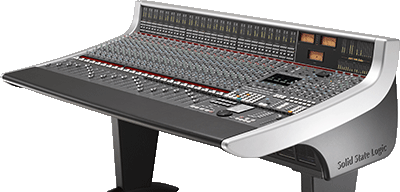
In 2015 SSL added δelta-Control system to the AWS console to enable use of standard DAW automation for control of the console analogue signal path. Further features also aimed at incorporating analogue processing into DAW based workflow have now been introduced. The AWS 948 is the stereo channel/in-line channel variant of the AWS console range (unlike the AWS 916 and 924 the mono channel variants). This new console update includes two new channel features that make specific use of the 948 stereo channel technology so are not applicable to AWS 916/924 consoles and require new console hardware so are not compatible with existing AWS 948 consoles.
The first addition is Stereo Channel Output rear panel connections. These enable Stereo channel mode stem recording in a single pass and in place, post pan, stereo stem generation in In-Line channel mode. These additions are ideal for users who print analogue processed content back to their DAW for streamlined future project recall. The second is independent insert In/Out switching on In-Line channels via a new soft key in the small screen Chan Setup page. This simplifies installation and expands the versatility of the Monitor path by sing the existing insert points for outboard processing instead of relying on patchbay access to the DAW playback outputs and desk inputs.
The graphics for the small screen signal flow GUI have been enhanced so that the Chan Setup page dynamically displays processing order and In/Out status on Stereo and In-Line channels. This software feature is compatible with all AWS 948 consoles.
All AWS consoles built from October 2016 will feature the new software and include the new hardware required to support the stereo channel outputs and independent insert switching. The new AWS 948 software which is compatible with all AWS 948 consoles, will include the new signal flow GUI and will be available as a free download from the SSL web site to all registered AWS 948 owners.
More: www.solidstatelogic.com
-
Solid State Logic SiX
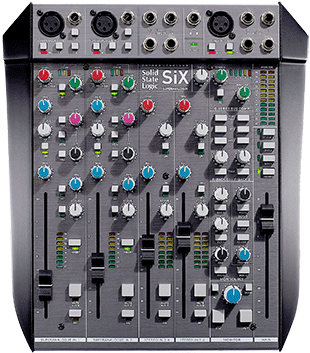 Solid State Logic has launched SiX, billing it as the Ultimate Desktop Mixer.
Solid State Logic has launched SiX, billing it as the Ultimate Desktop Mixer.SiX is claims classic SSL design credentials, with a feature set driven by total flexibility to cover as broad a spread of creative eventualities as possible. SiX aims for ‘big console sound’ and extensive utility features in a format that is small enough to be carried in a bag. It offers two recording channels with SuperAnalogue mic preamps, a one-knob version of the classic SSL Channel Compressor, a new two-band Channel EQ, inserts and 100mm faders.
There is a two-knob version of the G-Series Bus Compressor on the main mix bus and the Listen Mic Compressor on the Talkback. In mixdown mode, it is a very capable 12-channel summing system that offers analogue detail, depth and width to mixes.
‘With more than 30 years’ involvement in the design of SSL consoles, when developing the concept of SiX, I really thought hard on what our users appreciate about our larger consoles; what helps their workflow and delivers quality results for them’ says SSL Director of New Products, Niall Feldman. ‘The big challenge then was how to deliver those values and features in a compact product. Working with a great team and focusing on audio quality, workflow and flexibility, the resultant SiX mixer is one our proudest achievements’.
‘SiX is everything an SSL console should be, but at a price point that makes the SSL audio pedigree more accessible’ adds James Gordon, CEO of Audiotonix. ‘When Fusion launched last year we hinted it was the start of a new line of studio offerings and SiX is step two of that commitment.’
SSL SiX is available now, priced at £999 +VAT, US$1499+Tax, €1199 +Tax.
More: www.solidstatelogic.com
-
Solid State Logic δelta-control 24 plug-in
SSL has release a new δelta-control 24 plug-in and an Audio Units (AU) version of the δelta-control Single Fader plug-in for δelta-enabled AWS consoles. This update brings full δelta-control compatibility for Logic users.
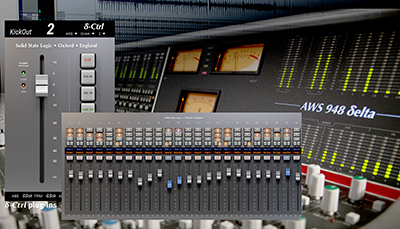
δelta-control is SSL’s plug-in family that allows analogue console automation to be recorded, edited and replayed via the DAW. δelta-control automation data is cross-compatible, meaning you can start mixing on one SSL δelta-enabled console and continue on another. Used in conjunction with the console’s Auto menu to access classic SSL automation functions such as Join and Revise, δelta-control offers a streamlined workflow suitable for the pressures and high-turnaround demands of the modern studio.
The δelta-control 24 plug-in allows AWS channel features to be automated from one plug-in including: Fader levels (Absolute and Trim), Cuts and Insert Points for both channel and monitor paths as well as EQ, Cue, and FX switches. The AU Single Fader version of the plug-in allows users to access Record and Mix Bus automation.
Both plug-ins will be free to download and use with δelta-enabled AWS consoles. The plug-ins will included in the AWS software download pack.
AWS consoles not running δelta can be upgraded with the relevant upgrade kit. δelta Control plug-ins are available in all major DAW formats including AAX, AU, and VST3.
More: www.solidstatelogic.com
-
Sony Music Studios installs Neve 88RS console in Tokyo
Sony Music Studios has installed a 72-channel Neve 88RS mixing console in its five-studio recording complex in Nogizaka, Tokyo. The large-format analogue desk replaces an Avid System 5 digital mixing set-up in Japan’s premier recording facility.
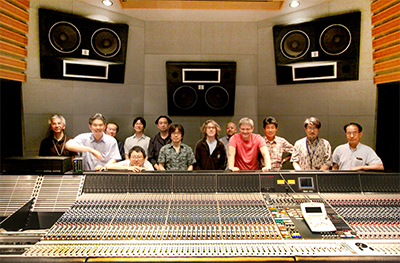
‘The original concept for Studio 5 was for surround-format mixing,’ recalls Chief Engineer, Koji Suzuki. ‘Back in 2001, when the studios were first established, it was easier for us to handle surround formats with a digital console, so we chose the Avid System 5. After 15 years, the console had become difficult to maintain, so we made the decision to replace it.’
Despite the proliferation of digital consoles in this kind of environment, replacing the Avid console with a wholly analogue console was a carefully considered choice by the Sony team. The 88RS is designed for great flexibility in surround mixing and coupled with its superior aural quality and longevity, provides the perfect solution for the studios.
‘Although there are operational advantages to a digital console, the Neve 88RS is timeless and durable, and its attraction does not depend on technical specification or trend,’ Suzuki explains. ‘As a matter of fact, the three 88R consoles in our Studios 1 to 3 have been used for more than 15 years, and moreover they will continue to be used for much longer.’
More: www.ams-neve.com
-
Sound Radix 32 Lives Version 2
Following the original 32 Lives audio unit plug-ins adaptor for Mac, Sound Radix has launched 32 Lives Version 2, with new VST compatibility and ‘sandboxing’ features for superior stability.
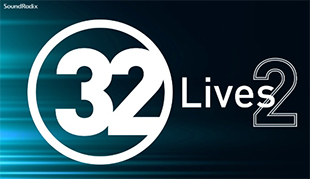
Sound Radix’s 32 Lives is a 32-to 64-bit adaptor promising transparency, compatibility, stability and optimal CPU performance, and allowing 32-bit system users seamless crossover to the latest 64-bit units even with legacy plug-ins – usually incompatible with modern systems (Abbey Road, TC PowerCore, URS). With 32 Lives, classic plug-ins can be run as if they were native 64-bits, while allowing recall of presets and previous projects on the original plug-in.
The new 32 Lives V2 takes the popular solution one step further, with a raft of higher-spec features for even tighter-tuned performance. Version 2 boasts all-new VST compatibility, enabling users to smoothly upgrade to the latest 64-bit DAWs, whilst maintaining backwards compatibility recalling previous projects on 32-bit VST plug-ins. New ‘sandboxing features’ separating each plug-in provide even greater stability, as one plug-in crashing will not bring down other plug-ins or the DAW host.
32 Lives V2 has a new-look design, multiple performance optimisations, an improved plug-ins manager application, new iLok authorisation, improved compatibility with Mac OS 10.12 (Sierra), and superior plug-in wrapping.
Existing users of 32 Lives software can upgrade to the new version free of charge. For users, the price will be the same as the original 32 Lives, at US$99.
-
Sound Radix Powair
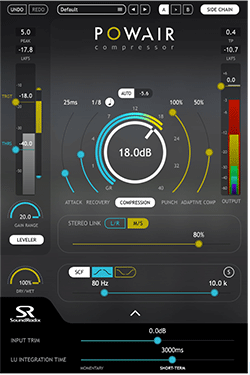
Sound Radix has released what it regards as ‘a smarter, more natural sounding dynamics processor’ in the Powair two-stage leveller/compressor plug-in.
Powair joins the company’s Auto Align and Drum Leveler to control dynamics and ‘bring a sense of power to vocals, instruments and mixes’. The first stage in Powair is a k-weighted perceived loudness (LKFS) auto-leveller able to deliver tracks to EBU specifications or control the levels of a dynamic performance. Powair uses an innovative gain detection and reduction engine, capable of fast gain changes with minimal distortion and adaptive response to the recorded source signal.
The characteristics of Powair allow powerful dynamics shaping while maintaining the timbre of the source material even when pushed to extremes. Its Punch feature gives control over the transients levels during the attack stage, making it possible to shape transient length while keeping peak levels under control.
Powair also features Adaptive Compression to maintain an average compression action, adding intensity and glue while keeping the natural dynamics in the recording, Sound Radix’ Nir Averbuch explains:
‘A couple of years ago Frank Filipetti pulled us as aside and said, “Listen guys, I work on this vocal track and I get the compressor to work all smooth and nice on this section and then when the loud part comes in, the compressor over-compresses and kills my sound. Now, I could automate the threshold but what I want is a compressor that will keep the sound I did in the soft part, in the loud part as well. Can you do it?”
More: www.soundradix.com
-
Sound studio move for Estudio A Sonido
Estudio A Sonido recently welcomed prominent Spanish pop group Taburete to with in-house producer Eduardo Figueroa and mix engineer Alberto Sanchez on new music as well as shooting music videos in the live room. Key to the sessions in the Torrelodones studio was a new 32-channel SSL Origin in-line analogue mixing console.
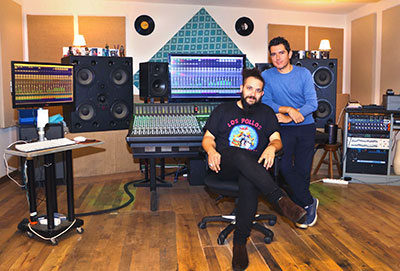 ‘There was a SSL 4000 E in the first studio I worked in, so after many years working with it I fell in love with the sound, and when I saw this new console, I knew it was the one,’ Figueroa recounts. ‘The most important aspect, for me, is that it is a vintage mixing console adapted to the workflows of the present day.’
‘There was a SSL 4000 E in the first studio I worked in, so after many years working with it I fell in love with the sound, and when I saw this new console, I knew it was the one,’ Figueroa recounts. ‘The most important aspect, for me, is that it is a vintage mixing console adapted to the workflows of the present day.’Already familiar with the physical features of SSL desks, Figueroa found the installation of the Origin and its integration into his studio infrastructure to be a breeze.
‘I am used to the external power supplies and thousands of wires, so the installation was very easy to understand,’ he says. ‘I love the possibility of adapting the interface and other rack hardware on the console using the modular centre section.
‘The greatest advantage that the system’s flexibility has brought to our workflow is the bus routing. It is easy and very fast, so mixing and monitoring for musicians is very quick. Essentially, the most time-consuming aspect of the job is now a lot faster.’
The studio’s workflow in itself is quite specific – recordings are made live with all instruments recorded simultaneously with the musicians in one room. To this end, the SSL Origin console’s hybrid flexibility and bus routing has significantly increased the speed at which different instruments can be sent to recording musicians, while its comprehensive solo controls have provided a choice of Solo-In-Front with mix balance, Solo-In-Place for large, small and group faders and PFL options.
‘We think this keeps the music alive and more real, and with all the instrumentals recorded and edited, we go to the next step which is vocal recording,’ says Figueroa. ‘The console makes this work very fast and intuitive, especially for the musician’s monitoring.’
With the Origin’s monitoring section, Figueroa and the engineering team are able to select their monitor source from the main mix, three external stereo sources or the front panel stereo 3.5mm jack input, with a Sum switch allowing selected sources to be listened to simultaneously. The console’s summing features have also proved particularly invaluable in facilitating the studio’s mixes.
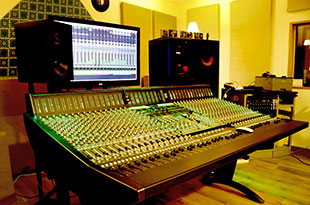 ‘Since we mix in the console, it’s important to us for it to have its own sound,’ Sanchez explains. ‘It has a different, fuller, presentation of dynamics and is deeper and richer in harmonics. With our mixes now – compared to previous mixes – everything is more clear and complete.’
‘Since we mix in the console, it’s important to us for it to have its own sound,’ Sanchez explains. ‘It has a different, fuller, presentation of dynamics and is deeper and richer in harmonics. With our mixes now – compared to previous mixes – everything is more clear and complete.’The crew at Estudio A Sonido have found the Origin’s functionality to be extremely useful during their day-to-day work, including its Bus Compressor, 0dB button fader bypass for stem printing, in front balance, sleep, solo and route clear features that further the speed of the workflow.
Having access to the E-Series four-band parametric EQ on each of the console’s 32-channels – with variable cut/boost per band, HF and LF bell/shelf switches, independent sweepable HPF on every channel and ‘242-style’ low end – has also given the team at Estudio an edge when it comes to mixing.
Meanwhile, Figueroa is also a big fan of PureDrive, Origin’s new discrete transistor mic-pre based around modern FET components, and says the result is an ultra-clean, ultra-low noise solution that offers stunning resolution when in Pure Mode.
‘SSL is a very well-known brand and lots of artists look for it in studios,’ Figueroa concludes. ‘With our new Origin console, we now have the ability to do whatever we want with the sounds we’re working with. It is excellent in every aspect and we couldn’t be happier.’
Located in just outside Madrid, the desk was supplied to the studio by SSL’s Spanish partner, Zentralmedia.
See also:
Damien Gerard installs first SSL Origin in AustraliaMore: www.solidstatelogic.com
-
Spain’s Musiluz expands teaching facilities with A&H
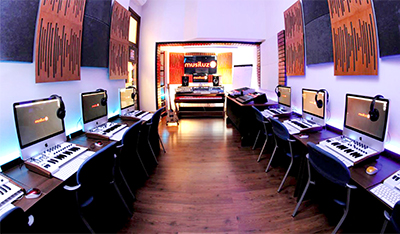 Part of an update to its A/V facilities, the Malaga’s Musiluz Sound School has added an Allen & Heath Qu-24 digital mixer.
Part of an update to its A/V facilities, the Malaga’s Musiluz Sound School has added an Allen & Heath Qu-24 digital mixer.The Spanish institute was founded in 2007, and is a nationally renowned training centre for DJ and music production, as well as being a Waves accredited school. Among its facilities, it counts studios for music recording and music production – dedicating studios to mainstream and classical music. Its new Qu-24 will serve music production and live music courses, and will be part of its audio postproduction set-up for film and television.
‘It is very important for us to have a compact, quality mixer that we can use in both the theory and practical classes,’ says Musiluz founder and Director, Ruben Albendín. ‘Our research showed that Allen & Heath had the system that best suited our needs for quality as well as functionality and integration with the most popular programmes on the market. The Qu-24 not only meets our expectations but has exceeded them! We are very impressed with the quality of its preamps, the motorised faders, Qu-Drive direct recording/playback, DAW integration, and the touchscreen and iPad app, which are fast and easy to use.’
More: www.musiluz.comMore: www.allen-heath.com -
Spartan Recording hits the road with SSL XL mixing
Built into a re-furbished and modernised original 1951 Spartan Royal Manor trailer, Spartan Recording is a new US-based mobile recording service owned and operated by Joe Costner. Central to its operation is an SSL XL Desk analogue console with integral 18-slot 500-format rack.
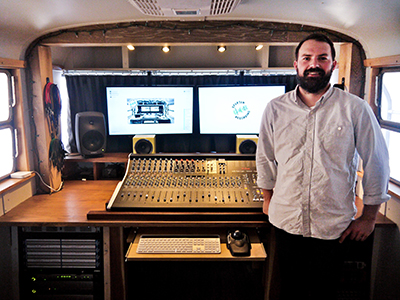 Based in California but available to bands across the US, Costner was inspired by classic rock recordings, made when the studio came to the artists and the live spaces were not necessarily built for purpose. ‘The idea is to travel, record in interesting spaces, and record those experiences,’ he says.
Based in California but available to bands across the US, Costner was inspired by classic rock recordings, made when the studio came to the artists and the live spaces were not necessarily built for purpose. ‘The idea is to travel, record in interesting spaces, and record those experiences,’ he says.‘It was really a hobby project that became something much bigger. I was just going to build this thing for myself, take it around the country and share it with people, but as I started building it the idea got bigger and a lot of people were pushing me to market it as a business.’
Costner notes that the studio itself is not normally used as the live space, though it does have its own isolation booth – mostly used for voice-over work. Technically, the facility is designed to use whatever buildings or environments are available at the destination.
‘I love the idea of artists being able to record in spaces that they are comfortable in, or spaces that they’ve always wanted to record in,’ he says. People have told me it’s a big change of pace – doing a take then walking outside, wherever you’re recording. Being out in the open gives people a new perspective.’
Costner purchased the XL Desk from Vintage King in Los Angeles after considering a range of analogue ideas. ‘I took in some stems from a session I did in Nashville and tried out lots of option. I wanted to bring analogue gear to bands, but in a trailer there’s not a lot of space to haul racks of outboard gear. The fact that the XL Desk has the 18-slot 500 rack built into it made it very easy for me to incorporate 500 format gear. That was a huge plus.’
The small footprint of the XL Desk was a significant selling point for Costner too. The XL Desk has a 21-fader frame, but packs in over 40 SuperAnalogue inputs, a full-featured monitor section, four stereo channels, two dedicated stereo returns, and four stereo mix busses. All inputs, returns, mix buses, and the listen mic compressor circuit feature direct outputs, while inputs and mix buses have access to the 500 rack as well as dedicated insert points. The console comes with a stereo SSL Bus Compressor in slots 17 and 18.
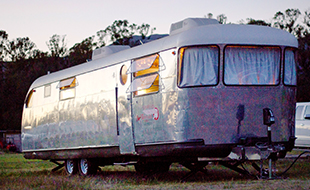
‘I wanted to give people a professional recording session, where you’re putting 12 mics on the drums in the same way you do in a normal recording studio,’ says Costner. ‘I’m still exploring all the routing possibilities – what I can do with the cue sends and the auxes - feeding headphones but also feeding FX down the channels. It really is a small version of a console you would use in a big analogue studio, but still with all the amenities.’
Costner currently has eight EQs in slots 1-8 and eight mic preamps in slots 9-16. As well as being available internally, these are also brought out to a patchbay: ‘If I’m doing a narration gig I’ll have a mic pre and EQ in line with the channel. For tracking bands I can use the console’s built-in VHD preamps, and the preamps in slots 9-16.’
He likes the idea of tracking with live takes where possible; it fits well with the inspiration behind the mobile studio: ‘A lot of people assume we’re recording just in the isolation booth, individually, but I’m trying to do this with live takes - running the cables into houses and buildings and having the band perform live is the kind of method I’d like to continue.’
He sees distinct creative advantages to this approach, possibly born of the process, and the resourcefulness in that process: ‘I think the “mobile” process of recording requires a lot of active listening – understanding how different rooms and environments are affecting your sound,’ he explains. ‘And it requires a lot of creative problem solving: Just because instruments look good set up one way, doesn’t mean they’ll sound good. Wherever you record, you definitely have to listen to the rooms and how your sounds live within that room. With the mobile studio I take a lot of time during setup, listening critically before I commit to a sound.’
According to Costner, his next purchase will be a four-track tape machine, both for printing mixes and for use as a process for things like stereo drum mixes: ‘I’m always looking to expand with more outboard while conserving space. It’s important to me that people don’t feel cooped up or confined when they enter the mobile studio.’
‘To be able to do quality recordings in the same space you live in, rehearse in, or vacation to, is a huge luxury. It’s a very enjoyable process that delivers some very interesting results.’
See also:
Recording in an AirstreamMore: www.spartanrecording.comMore: www.solidstatelogic.com -
Sponsored Video
A selection of instructional, educational and entertaining videos from pro audio and A/V
-
SSL adds Precision presence to NYC profile
In NYC’s Precision Sound Studios, owner and engineer/producer Alex Sterling has created an oasis of technical excellence and creative expertise on the Upper West Side of Manhattan. As part of a recent re-fit and overall technical upgrade, he has installed a 48-channel Solid State Logic Duality δelta Pro Station SuperAnalogue mixing console in Control Room A.
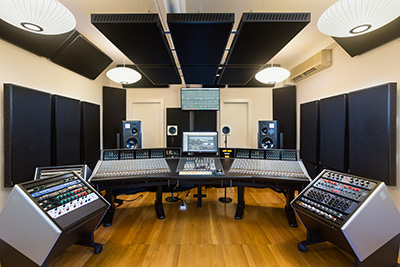 The upgrade was specified by Sterling and implemented by the Malvicino Design Group, and includes a comprehensive wiring scheme, a large video screen for Film/TV post work, and overall layout adjustments and refurbishment
The upgrade was specified by Sterling and implemented by the Malvicino Design Group, and includes a comprehensive wiring scheme, a large video screen for Film/TV post work, and overall layout adjustments and refurbishment‘I have always wanted to create a working space for music production that has the comfort of a person’s home or living room but with the technical and professional capabilities of a larger commercial facility,’ Sterling explains.
The live room can host around 15 musicians, which means that Sterling is as in demand for band recording, film and television work as he is for electronic, pop, and hip-hop mixing and production. The new Duality δelta console is a creative tool that meets his own standards, yet also puts his studio onto a more high-end commercial footing with outside producers: ‘During my console search I carefully researched and demoed several other modern consoles, many of which did have some substantial sonic attributes, however the Duality has the most developed functionality for a modern workflow and its sonics are spectacular.’
‘The integration with the DAW was very important to me, as was the high channel count – and having a full complement of processing available on every channel,’ he adds. ‘I could be spending twice as much to get full filters, dynamics and EQ on every channel with another console, and I still wouldn’t be getting any of the DAW control functionality that Duality offers.’
One of the most striking features of the studio is the live room space, which also happens to be a library of around 3,000 books. ‘Believe it or not, they have an acoustic value as well as an aesthetic value,’ says Sterling.
Precision Sound has been operating with the new console for several months; the first session was a TV scoring session for composer Michael Bacon. ‘That was a good first test,’ Sterling reports. ‘Everything was flawless, everything sounded great...
‘I’ve used the console’s channel preamps for most of the tracking that I’ve done through the desk. I was not expecting to like the preamps as much as I do. For tracking, the SSL preamp is as transparent as any of the esteemed, clean boutique pre-amps, and it’s extremely low noise, which some other preamps just can’t claim.’
Sterling is also complimentary about the SuperAnalogue bus architecture of the Duality: ‘One of the things I’ve been experimenting with is using the console’s mix bus to give me volume and level for a final mix print, but without having to use peak limiting. By driving the console mix bus with a lot of level, I am able to get a much more aggressive full and forward sound – without needing to lose or cut off transients with a dynamics processor for volume.
‘I’ve been shocked how rich and full I can make things sound by essentially ignoring the vu meters and letting them pin completely into the red – completely brutalising the capture chain. The desk can really take it. You can clip the channels a bit, but the mix bus itself is pretty much unclippable. At least, I haven’t managed to do any damage with it yet.’
For Sterling, the last few months have proven that the Duality delivers sonics, an integrated DAW workflow and a creative approach to production: ‘To my ear, signal processing is generally superior in the analogue domain,’ he says, ‘But some of the creative things that people are doing now really only exist within the DAW environment. To not become disconnected from the DAW while working on the console was very important to me because I’m working on modern productions that have modern production requirements. This console really has set the professional standard for this decade.’
More: www.solidstatelogic.comMore: www.malvicinodg.com -
SSL AWS Rides into OX4
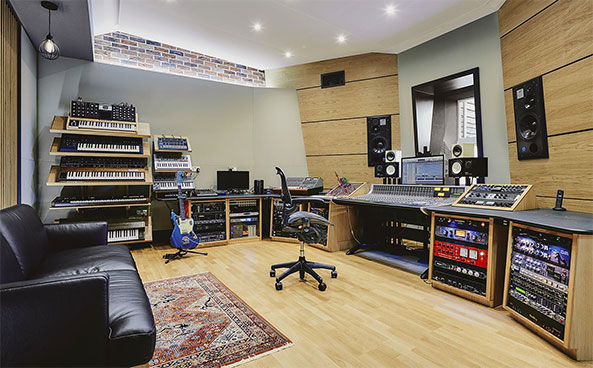
Having made a big splash with Ride during the ‘shoegazing’ period of British alt/rock during the late 1980s (and who reformed in 2014), frontman and guitarist Mark Gardener developed a strong interest in recording and studio production. Now, with Ride about to release a new album, Gardener has opened OX4, a multi-room studio facility in Oxfordshire, built by Studio Creations and with an SSL AWS 948 console as its centrepiece.
‘It constantly surprises me, the Ride phenomenon,’ Gardener muses. ‘We did a big thing first time around, but now we are playing bigger shows than we ever did back in the day. But I always thought one day it would level off, so in the interim I got heavily into recording, trying to demystify the process of being in the studio. It’s always been my thing, really.’
-
SSL explores new Grounds at Maverick Music
Specialising in projects recorded with real instruments and accomplished musicians, Lincoln Grounds is a versatile, busy UK-based Media Composer. At his Maverick Music studio, his production workflow gives him the support he needs but stands clear when the players are in. In line with this thinking, he recently invested in an SSL XL-Desk.
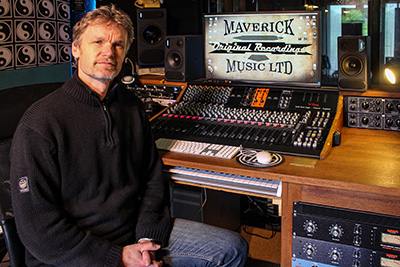 Grounds has more than 430 tracks logged with Audio Network – a music content provider for the production industries that has made a name for itself turning over an incredible amount of original music but without compromising quality. For him, that’s a perfect fit: ‘I’m not a classic modern media composer because I hardly do anything with Midi,’ he says. ‘I don’t have any fancy sample libraries. I do almost everything though microphones – and with real musicians.’
Grounds has more than 430 tracks logged with Audio Network – a music content provider for the production industries that has made a name for itself turning over an incredible amount of original music but without compromising quality. For him, that’s a perfect fit: ‘I’m not a classic modern media composer because I hardly do anything with Midi,’ he says. ‘I don’t have any fancy sample libraries. I do almost everything though microphones – and with real musicians.’Audio Network has been very supportive of this approach, obviously valuing his results. ‘I get to pick and choose quite a lot of projects, including a lot of marimba-based tracks, orchestral tracks, and a lot of Americana. For that I go off to Nashville quite often.’
The XL-Desk now installed in Grounds’ studio could be considered a traditional 24:8 analogue console, but with a few twists – including a wealth of routing and I/O options. It features dual input channel strips with SSL VHD (Variable Harmonic Drive) mic pres on the first eight and an additional 18 500-format rack slots available for processing or additional mic preamps – accessible by channels and buses. A 500 format SSL bus compressor comes as standard and is hardwired into bus A, while an additional three buses (B, C, and D) can be summed into bus A as required, and a Cue Stereo Bus for headphone mix can be repurposed at mix down to give 40 summing inputs.
‘It’s important that I have lots of different mic press and lots of microphones,’ says Grounds. ‘And they all have their dedicated channel, and they are always plugged in. That way there’s no buzz-kill when I’m recording. I just have to unmute the channel and go. That’s a big reason why I have a desk.
Grounds has a variety of 500 format mic preamps and EQs installed in the XL-Desk from several different manufacturers. He also has a different stereo compressor on each of the four buses, and two sets of monitors (large and small) permanently connected. ‘The console is probably the biggest investment in a studio. It’s the first thing that gets switched on every day, and everything I record is going through it. I can’t work without it, so it must work every single time; it must be reliable and it has to sound great. This console has a tonne of headroom. I don’t think I’ve ever seen it peak. It just gets out of the way and everything sounds the way you want it to sound.’
Even though Grounds mixes in the box, he has always had a console in his studio and has built up an appreciation for capturing performances from the beginning and committing to creative decisions at the tracking stage. This approach has been nurtured during the time he has spent in Nashville amongst some of the best session musicians in the world.
‘There’s are lot more people working like that over there,’ he explains. ‘Using EQ and compression on the way in and mixing inside the box. I don’t do cut and paste. Even if there’s a tambourine on one of my tracks, I’ll play it from beginning to end. I’m so old-school it’s ridiculous.’
By putting emphasis on capturing and shaping a performance on the way in, Grounds says he gains much in terms of speed and efficiency: ‘If you’ve got good players and you’re ready to work really fast. It’s worth it because you don’t have to edit – you only have to arrange and mix.
‘Of course, it’s also about the performance. For 60 per cent of what musicians do you probably couldn’t tell the difference between them and high-end samples. But now and again you’ll get a ‘musiciany’ thing – a trill, a feel, a dynamic –and it doesn’t matter how you programme something, you could never make it sound that natural.’
A simple, uncluttered workflow at the tracking stage is an important part of Grounds’ recipe for a perfect performance. And because it’s often him who is performing, quite a few of the hybrid console features would be superfluous. ‘I could have gone with DAW control and automation and all of that stuff,’ he says. ‘But I’m not a techy-enough person to have that in my head when I’m working. I’d rather have chord progressions and harmonies at the forefront of what I’m doing.
‘The XL-Desk is simple, yet clever. There are no features that I don’t use, so I haven’t spent any money on features I don’t need.
‘I’ve got a bunch of outboard options that I use on the way in, and it’s easy to patch that without having to get up and change things around. I can patch in a Pultec with my guitar still in my lap. That’s awesome.’
More: www.solidstatelogic.com
-
SSL XL-Desk takes off at Rocket Science Recording
Glasgow’s Rocket Science Recording Studios has installed a Solid State Logic XL-Desk – the latest chapter in the story of a studio that began life simply to serve its founders’ needs.
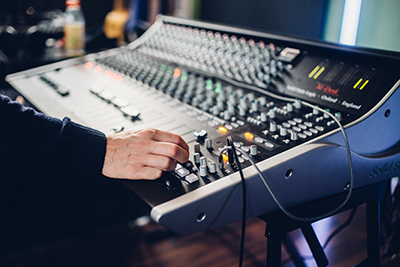 ‘It was somewhere to put our gear and somewhere to work on our own music. But within the first two weeks someone phoned up and asked to book in! It has grown steadily ever since,’ says Michael Bannister who established the facility with Ross Hamilton in 2010.
‘It was somewhere to put our gear and somewhere to work on our own music. But within the first two weeks someone phoned up and asked to book in! It has grown steadily ever since,’ says Michael Bannister who established the facility with Ross Hamilton in 2010.‘We try not to grow too fast – we’ve seen lots of studios in Glasgow pop up, get loads of gear, then in a year they’ve gone again,’ he warns. ‘We’ve concentrated on choice bits of gear by researching what exactly it is we need – what will push us up to the next level. We started with monitors, then waited a while and got some outboard, and so on. The last things we got were great convertors and now the desk. Though now we’re thinking it’s a shame we left the desk until the end.
Located on the West side of Glasgow, the studio’s clients are served by a large control room and three live rooms.
Prior to purchasing the XL-Desk through UK distributor Sound Technology, Rocket Science had been replying on a more basic summing mixer. According to Bannister, a significant consideration was whether the SSL would really make a difference to the existing signal path.
‘It has made a massive difference,’ he reports. ‘We were looking for that punch and clarity that we couldn’t find anywhere else. The desk has brought that to us. The built-in Mix Bus Compressor has been a big thing – it does something special, to bring a commercial sound to the music – especially that version of it with the high-pass filter sidechain... The bottom end that we’ve been getting is so different from the bottom end we were getting before.
‘It’s also sped up our workflow,’ he continues. ‘We have to do a lot less in Pro Tools now. We’ve noticed we’re using fewer plug-ins and actually think we were compensating for the summing bus we had before, with more plug-ins. With the SSL we don’t have to do that. Even when we recall old sessions through it, there’s an immediate jump in quality, which is fantastic.’
The SSL XL-Desk has an 18-slot 50-format rack built-in, accessible from channels or mix buses. The Rocket Science console’s rack is populated entirely with SSL’s 500 format E-Series EQ – an easy way for the studio to make a big jump. ‘We’ve got quite a lot of outboard,’ Bannister explains. ‘But probably the one thing we were lacking was outboard EQ. Obviously many people have had these EQs as plug-ins, but when you get the real one the difference is incredible.’
Hamilton and Bannister have kept to the original summing arrangement for the most part, but have also started to explore some of the flexibility that XL-Desk can bring to that role. ‘We use the first eight channels, which have the VHD preamps, for tracking, and we use Channels 9-24 for summing the returns.
‘We’ve been using flexible Mix A, B, C and D buses as well, taking advantage of their routing capabilities… Around about the same time we bought the SSL we also got an outboard stereo compressor so, spoilt for choice – as you get the SSL Stereo Bus Compressor on the Mix A bus of XL-Desk – we’ve been experimenting with putting the outboard compression, set to a crazy, heavy compression, strapped over the Mix B bus.’
Their discerning approach to technology aside, it’s Bannister and Hamilton have a wide range of talents – engineering, song writing, producing, and playing – and have put their skills to use on more than just straight music recording and mixing, through a number of high-profile advertising projects and broadcast mix projects.
‘We’re lucky,’ Bannister reflects. ‘People come to us because they want us to play on stuff and produce more than anything. We don’t get many people just wanting to record. Quite a lot of our clients are individuals so Ross and I, between us, track everything and do a lot for them. But the SSL does make a big difference – even people who don’t know about music, know about SSL.’
More: www.soundtech.co.ukMore: www.solidstatelogic.com -
Sterling Audio studio mics
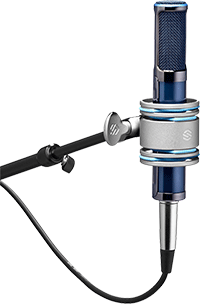 US mic specialist Sterling Audio has announced a line of studio recording microphones comprising six individual mics, a two-mic package, and two new shockmounts.
US mic specialist Sterling Audio has announced a line of studio recording microphones comprising six individual mics, a two-mic package, and two new shockmounts.The ST170 Active Ribbon Microphone has a fig-8 pickup pattern and is optimised for electric and acoustic guitars, drums, vocals and overhead/room tracks. Phantom-powered, it handles up to 132dB SPL for handling high SPL sources such as guitar amps and drums. The ST170 comes with Sterling Audio's SM5 metal shockmount and aluminium case.
The ST169 Multi-Pattern Tube Condenser Microphone has a 1-inch diaphragm and class-A valve preamp for capturing vocals, instruments, speech and overhead/room recording. It offers selectable cardioid, omni, and fig-8 polar patterns, and has a switchable high-pass filter and attenuation pad capable of handling up to 142dB SPL. The mic comes with the SM8 metal, band-suspension shock mount, aluminium case, and low-noise power supply.
The ST155 Large-Diaphragm Condenser Microphone features a 1-inch large-diaphragm for recording vocals, instruments and speech. Its hand-assembled capsule and custom-wound transformer are accompanied by switchable high-pass filter and attenuation pad handling up to 144dB SPL from 20Hz to 20kHz. It also comes with SM8 shockmount and case.
The ST131 features a hypercardioid polar pattern, custom-wound transformer and hand-assembled, 1-inch capsule for a variety of recording applications. The ST159 Multi-Pattern Condenser Microphone's selectable cardioid, omni and fig-8 polar patterns.
Sterling also is shipping the SP150/130 Studio Condenser Microphone Pack, which provides two professional class-A FET cardioid microphones. The side-address SP150 is optimised for vocal, instrument and speech recording, while the end-address SP130 instrument is suited to fast transients and clarity.
Sterling has released two shockmounts – the SM5, which can accommodate a variety of medium-body (1.2 to 1.7-inch) studio microphones and the SM8, which fits any Sterling large-diaphragm microphones (1.6 to 2.4-inch body diameter).
More: www.sterlingaudio.net
-
Studio28 adds to orchestral appeal with Duality mixing
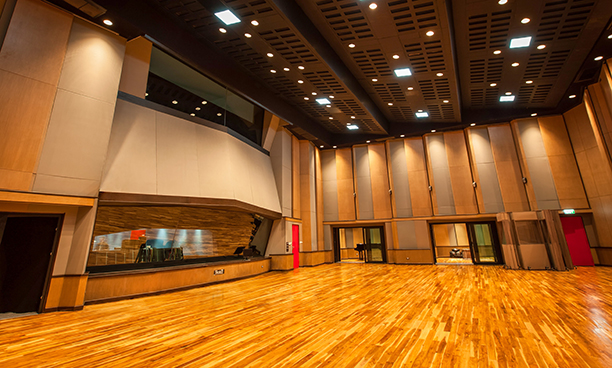
Designed and built from the ground up for orchestral recording, Thailand’s Studio28 has raised both its domestic and international games with the installation of a 48-channel Solid State Logic Duality δelta SuperAnalogue console in its Studio A control room.
The choice of an SSL Duality console was integral to that ambition: ‘We picked that console for many reasons,’ Fang Riewpakorn says. ‘The great sound, its flexibility, the SSL name, and the SSL support...’
-
Tascam DR-40X/DR-07X/05X handheld recorders
Tascam has expanded its line of professional handheld recorders, the DR-X Series, aiming the DR-40X at videographers, voiceover artists, songwriters, and podcasters, the the DR-07X at music recording and spoken word, and the 05X at music recording, meeting logging and dictation.
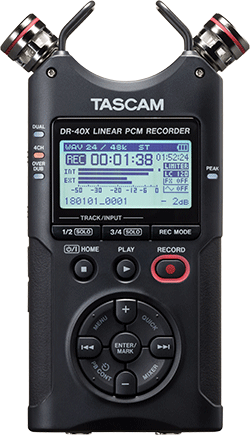
The DR-40X offers integrated unidirectional stereo mics with scalable A/B or X/Y configuration, dual XLR/quarter-inch combo inputs, built-in phantom power for condenser mics, integrated 4-track recording, and wired remote control option. DSLR filmmakers will additionally benefit from the Auto-Tone function, providing an audio cue tone identifying each recording take.
The ‘powerful yet affordable’ DR-07X has dual, integrated, scalable unidirectional A/B or X/Y configurable mics, while the DR-05X incorporates all of the DR-07X’s features minus the scalable microphones – instead, it is equipped with a pair of omnidirectional condenser mics.
The DR-X Series also taps into Tascam’s computer-based recording experience,with a studio-quality 2input/2-output USB audio interface that makes all DR-X Series recorders well suited to live streaming, podcasting and digital audio workstations.
All DR-X models boast a totally revamped user interface, making it easy to access recording, adjusting levels, deleting takes, adding markers, and other common functions. Multi-language menus in English, Spanish, French, Italian, German, Russian, Chinese, Korean, Japanese and Portuguese are included. And with increased capacity for microSDXC cards up to 128GB, DR-X Series recorders can literally operate for days on end.
Other features include a bright white backlit display that’s easy to see even in bright sunlight, as well as Dictation Mode, which enables the user to instantly jump back audio playback in preselected increments including speed control and a special dictation EQ, and Overwrite Mode, which allows users to select a precise record drop-in time for replacement recording with one level of undo. The DR-X Series’ Auto-Recording function can be set to begin recording when a sound is detected, and its Pre-Recording function delivers fail-safe recordings with up to 2 seconds of pre-record time.
DR-X Series recorders are available now. The DR-40X carries an estimated street price of US$199.99; the DR-07X US$149.99 and the DR-05X US$119.99
More: www.tascam.com
-
Tascam iXR USB Audio/Midi interface
Tascam has announced the iXR USB Audio/Midi interface with iOS connectivity.
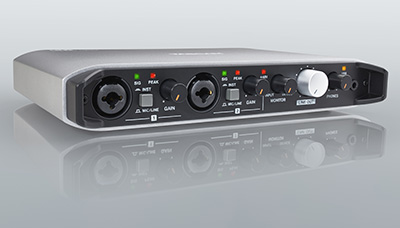
Designed to bring professional audio to mobile devices, the iXR is a full-featured USB audio interface for iPhone and iPad, using the standard iOS Lightning or 30-pin connector.
Featuring two of Tascam’s Ultra-HDDA mic preamps with phantom power, mic and instrument-level inputs, zero-latency monitoring, Midi In and Out, and supporting up to 96kHz, 24-bit resolution, the iXR is intended for use at home, on stage or in the studio.
With balanced stereo outputs, the iXR also bridges an iPad and a professional quality concert sound system. As virtual instrument apps have evolved, instruments like Cakewalk’s Z3TA+ and moForte’s GeoShred are lending the iPad a professional level of music performance. ‘We designed GeoShred to take advantage of the iPad’s touchscreen interface, as well as its processing power,’ says moForte’s Pat Scandalis. ‘Now, with the iXR, artists can fully unleash the unique sonic capabilities and dynamic power of our one-of-a-kind instrument.’
Bundled with Cubase LE for Mac and Windows, as well as Cubasis LE for iOS, the iXR can be part of a digital recording system. ‘Tascam created the Portastudio multitrack experience, and we’ve continued to perfect it,’ says ‘Tascam Executive VP, Jim Mack,. ‘Today’s artist has a wealth of different musical resources at their fingertips, and the iXR is the first interface of its kind that ties them all together.’
The Tascam iXR will carry an MSRP of US$259.99 and a street price of US$159.99.
More: www.tascam.com
-
Tascam Model 24 digital multitrack recorder
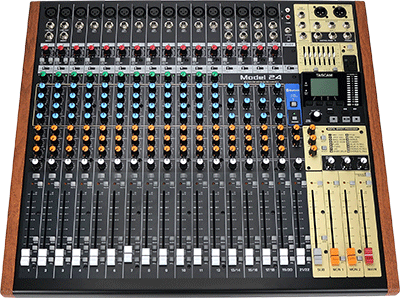 Tascam’s has released the Model 24 digital multitrack recorder, offering 24 tracks of 48kHz, 24-bit audio capture (22 channels and a stereo main mix) and 22 playback tracks via either USB 2.0 or to an onboard SD Card recorder. With colour-coded knobs, faux-wood sides, and a retro design, the Model 24 is reminiscent of vintage Tascam products but is based on the company’s digital Portastudio technology with LCD screen and digital recording and Bluetooth input features.
Tascam’s has released the Model 24 digital multitrack recorder, offering 24 tracks of 48kHz, 24-bit audio capture (22 channels and a stereo main mix) and 22 playback tracks via either USB 2.0 or to an onboard SD Card recorder. With colour-coded knobs, faux-wood sides, and a retro design, the Model 24 is reminiscent of vintage Tascam products but is based on the company’s digital Portastudio technology with LCD screen and digital recording and Bluetooth input features.The Model 24’s SD Card recorder offers quick, easy one-touch recording and includes transport controls, auto and manual punch in/out, and overdub capability. Mixdown employs built-in 22-channel mixer using 100mm faders, as do the two monitor returns, subgroup bus, and stereo main bus also.
The Model 24 offers 12 mono channels, each with XLR mic and quarter-inch line inputs; quarter-inch Inputs 1 and 2 can be switched between line and instrument level, enabling plugging in a guitar or bass, and feature a quarter-inch TRS insert point. There are four stereo channels with mono XLR mic and left and right quarter-inch line inputs. All 16 microphone inputs sport a preamp gain control and an overload (clip) indicator for the channel’s mic preamp. Each of the first 20 channels includes mute and PFL solo.
An additional stereo channel (21/22) is equipped with unbalanced RCA, unbalanced stereo mini-jack, and wireless Bluetooth connectivity and offers Mute and Pairing buttons. This enables streaming audio from a laptop or mobile device. Stereo channel 21/22 has also been optimized to feed the Monitor 1 and Monitor 2 buses via rotary auxiliary send controls.
A Routing Mode selector enables each channel to be independently set to accept live input, the return from the USB bus, or the return from the SD Card recorder. This enables you to overdub in the studio and to fly in backing tracks for live performance. Multi-segment LED meters monitor the stereo main bus output levels. Outputs include stereo XLR and quarter-inch main outputs, two quarter-inch monitor sends, an effects send, stereo control room outputs, and a stereo quarter-inch headphone monitor output.
Each of the 12 mono channels include a simple one-knob compressor, a low-cut filter, and three-band semi-parametric EQ with sweepable midrange. The compressor and low cut filter are pre-Routing Mode selector so they can be applied to any recording track. The stereo channels include a low-cut filter and three-band fixed EQ. A stereo seven-band graphic EQ with easy-control toggle buttons and instant bypass can be applied to the main mix or monitor outputs, enabling you to shape your mixes and prevent monitor feedback. An onboard stereo multi-effects processor lets you apply 16 preset effects, including reverb, delay, chorus and flanging.
More: https://tascam.com
-
Tascam Track Factory bundle
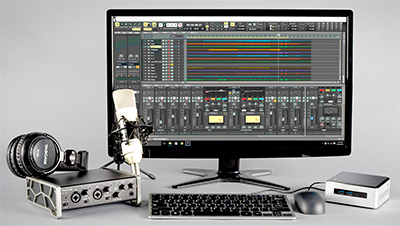 Tascam’s Track Factory is a complete audio production system designed for music making ‘rather than being simply a computer bundle’.
Tascam’s Track Factory is a complete audio production system designed for music making ‘rather than being simply a computer bundle’.Track Factory is built around a powerful Intel NUC mini-computer that has been preconfigured for music production, and includes everything needed to plug in and begin recording. Built with hand-selected hardware components and equipped with a 2.7GHz Intel Core i5-5250U processor with 3MB of cache, 8GB of RAM, and a 256GB M.2 solid-state drive – desktop PC power in a, 4x4-inch form factor. Connections include four USB 3.0 ports, a Mini Display Port 1.2, Mini-HDMI 1.4a port, gigabit Ethernet, Wi-Fi and Bluetooth 4.2. It runs a version of Microsoft Windows 10 Home Edition that has been optimised by PC Audio Labs for digital multitrack recording and editing. A USB mouse and keyboard are included.
Cakewalk’s Sonar Professional DAW comes preinstalled and configured for the bundle’s Tascam US-2x2 USB 2.0 audio/Midi interface. Sonar Professional comes with a wealth professional effects, loops, and virtual instruments, including the ProChannel Console Strip and Melodyne Essential with ARA integration.
Tascam’s US-2x2 interface features two combo mic/line/instrument inputs with high-end Ultra-HDDA microphone preamps. Ioffers two balanced TRS line outputs, records at up to 96kHz, 24-bit audio resolution, and offers zero-latency monitoring.
A Tascam TM-80 medium-diaphragm cardioid condenser microphone and USB cable are included, as are a pair of Tascam TH-02 closed-back headphones.
Tascam supplements the preconfigured Track Factory system with tutorial videos and a Quick Start Guide. The Track Factory bundle is available for a MAP/street price of US$1,299.99.
More: www.tascam.com